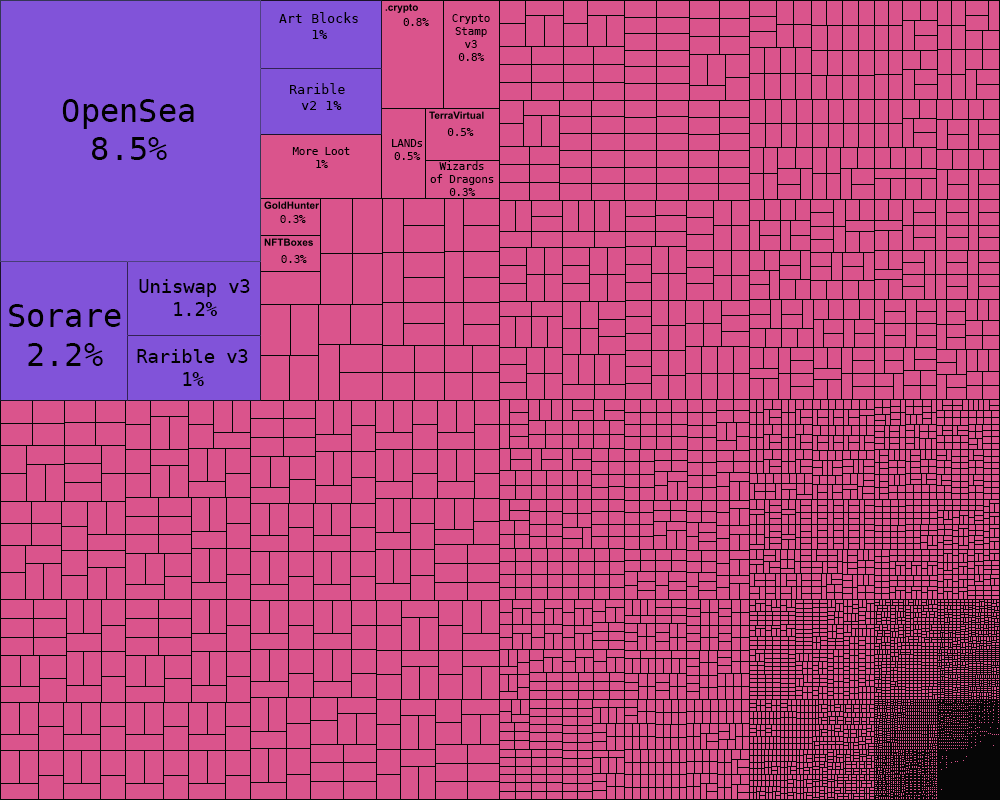What is an NFT
An NFT is a "non fungible token" composed of a contract, token, metadata, and an image/video file. They can represent anything, including digital art, virtual property, and investment positions. Many people believe that data on the blockchain lasts forever. While that is true, after reading the specifications (1,2) and analyzing how they are implemented in practice, most NFTs are not immortal. The rest of this article will explore.
The Contract and Token
The root of an NFT is the contract. Contracts are arbitrary code. Contract owners can often modify your NFTs after you purchase them, either by explicitly allowing the operation or by upgrading the contract.
That being said, there is a lot of contract diversity on Ethereum blockchain and it is likely many of those contracts are honest. Each rectangle below represents a contract and their relative size indicates the number of tokens minted by the contract.

- Open Sea
- The largest NFT marketplace. Facilitates trades and allows users to mint their own NFTs using their contract.
- Sorare
- Online game where users buy officially licensed cards representing soccer players and build teams
- Uniswap 3
- Automated Market Maker (AMM) and critical infrastructure for decentralized finance.
- Rarible
- Another NFT marketplace. Facilitates trades and allows users to mint their own NFTs using their contract.
- Art Blocks
- Platform focused on the curation of programmable generative art.
The Metadata and Images
The metadata for an NFT can link to an image/video and include any other data the NFT's creator wishes. Because of their size, it is common for the metadata and images to be stored off the blockchain and just use the blockchain as a pointer. HTML and IPFS are usally used for offchain storage.
-
9% On Chain
- On chain NFTs are immutable and permanent. They are rare as publishing data on chain is expensive.
-
36% IPFS
- NFTs stored on IPFS can not be changed but they can disappear if no IPFS peers have a copy.
-
55% HTTP
- HTTP NFTs are stored on a central server and can be modified and will disappear when the server goes offline.
If an NFT is served via IPFS or HTTP it is at risk of disappearing. You will find articles warning of this danger but none have data. Given NFTs have been around since ~2015 and approximately 5% of them are no longer available, they are far from permanent.
Making NFTs available on IPFS significantly improves the odds they remain online. In particular, as the owner, you can pay to pin them ensuring they stay online. This does not require cooperation by the contract owner.
Unfortunately, many of the biggest NFTs have not leaned into IPFS. For example, OpenSea serves most of the NFTs they mint over HTTP. If the OpenSea ever collapses, ~8% of NFTs vanish.
Getting the Data
I hoped to distribute a copy of all the NFT images/video via torrent but there are more than 14TBs on the Ethereum block chain! So, that wont be happening... The metadata, contract addresses, and token ids are ~5GB and can be downloaded via torrent. The 5GB contains most of the data used in this analysis.
If you want a copy of all the images/video you can use the metadata to bootstrap your own download or send me an email at yournfts4.